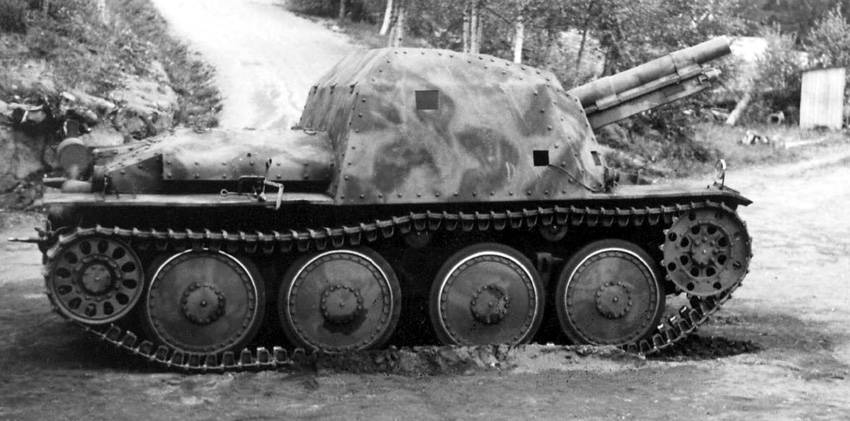
During World War II, Sweden remained neutral, but the world situation did not allow to stop the development of the armed forces. Both before and after the war, the defense industry of neutral Sweden carried out new projects of armored fighting vehicles. Several examples of this type, created at this time, determined the appearance of the Swedish armored vehicle fleet for many years.army. For example, the Stormartillerivagn m/43 self-propelled gun remained in use for several decades to come.
The story of the Stormartillerivagn m/43 self-propelled gun begins in September 1941, when the Swedish army command requested the creation of a promising armored vehicle capable of increasing the offensive power of the ground forces. According to the submitted terms of reference, the army needed a self-propelled gun platform capable of operating in the same combat formation as existing tanks and infantry. It was especially noted that such a model had to be adapted to the typical Swedish weather and landscape conditions. The new self-propelled gun was supposed to be able to fire both direct fire and from closed positions.
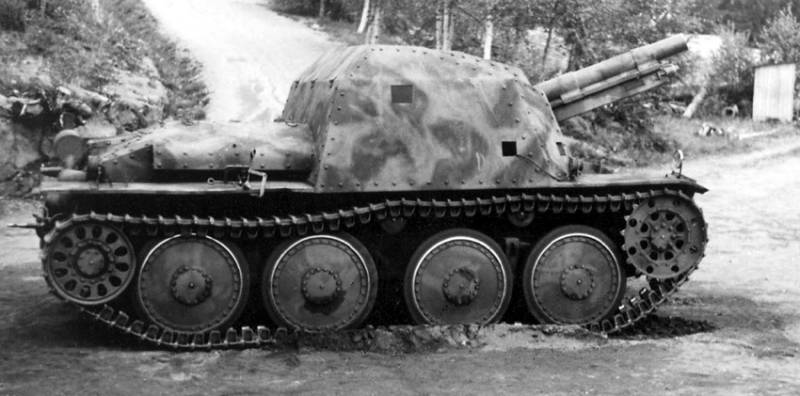 ACS Stormartillerivagn m/43 in its original configuration with a 75 mm gun. Photo Ftr.wot-news.com
ACS Stormartillerivagn m/43 in its original configuration with a 75 mm gun. Photo Ftr.wot-news.comThe easiest way to create an armored vehicle with the necessary characteristics was considered to be to equip a ready-made serial chassis with a working gun. However, finding suitable components for such an ACS turned out to be quite difficult. At that time, Sweden was equipped with several tanks with suitable characteristics, each of which could be considered the basis for a new self-propelled gun. In this regard, for some time, additional studies and tests were carried out, the purpose of which was to select the optimal chassis.
Also at a certain stage, there were problems with the choice of weapons and their placement. It turned out that guns with long barrels did not correspond to the landscape, besides, they were illegal. Relatively long trunks when moving in the forest could touch trees. Also in such conditions, trees could impede the rapid spread of fire to a large angle. Finally, the rules of that time prohibited the operation of vehicles with some parts protruding beyond the front part of the hull.
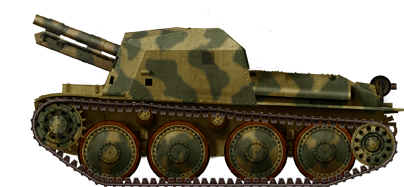 Reconstruction of the appearance of the ACS of the first version. Image Tanks-encyclopedia.com
Reconstruction of the appearance of the ACS of the first version. Image Tanks-encyclopedia.comBased on the results of quite complex comparative tests and numerous theoretical studies, the optimal appearance of a promising self-propelled gun was formed. The chassis of the Stridsvagn m/41 serial light tank was considered the most successful for use in the new project. The Bofors m/02 and Bofors m/44 guns were considered the main armament, differing in caliber, but at the same time having a rather short barrel. To install the proposed guns on the existing chassis, it was necessary to remake the existing armored hull. Other elements of the chassis could remain unchanged.
The development of the new project was entrusted to Scania-Vabis. This enterprise had already managed to establish mass production of the Strv m/41 light tank, and therefore, in the future, it could master the creation of self-propelled guns without any problems.
The design and construction of the first prototype of the new technology was completed in 1943. In this regard, and also taking into account the role on the battlefield, the new armored vehicle received the official designation Pansarartillerivagn m / 43 (“Armored Car Type 1943”) or Pav m / 43. However, this name did not have time to be assigned to the entire project. All subsequent self-propelled guns were designated Stormartillerivagn m / 43 (“Assault Gun Car Type 1943”) or Sav m / 43. It is under this name that the new self-propelled gun remained in the history of the Swedish army. It should be noted that this name was applied to all variants of the device, regardless of the features of its design and armament.
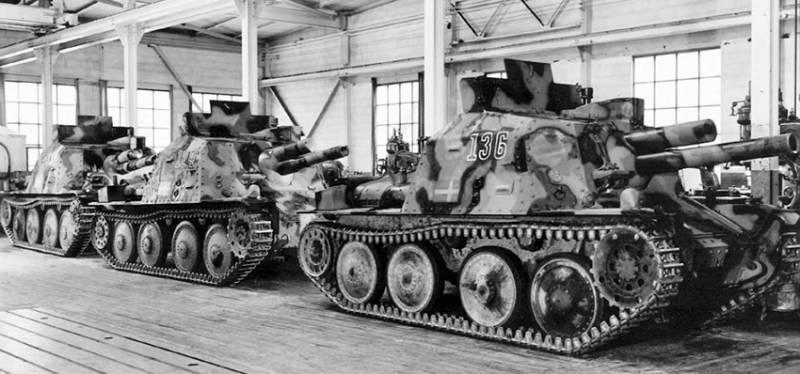 Upgraded Sav m/43, equipped with 105mm gun. Photo Ftr.wot-news.com
Upgraded Sav m/43, equipped with 105mm gun. Photo Ftr.wot-news.comThe light tank Strv m/41 was a licensed copy of the Czechoslovak LT vz.38 and did not differ in design. For use in the new Pav m/43 / Sav m/43 project, the existing machine had to be significantly modified. The base tank lost its turret and turret box, instead it was necessary to install a wheelhouse with a new fighting compartment. It was also required to remake the lower elements of the case. The power plant and running equipment remained unchanged without any changes. All this made it possible to solve the assigned tasks without significant complications of the project.
The redesigned hull retained the boxy frontal assembly, the front of which consisted of several inclined sections. The longitudinal armor plates were also retained. Instead of the turret box behind the upper front, a large plate with gun mounts was now placed. On its sides were inclined zygomatic plates, joined to the sides scattered inward. Behind the chop was protected by a pair of plates located at an angle to each other. A roof of complex angular shape was used, consisting of several inclined sections. The stern of the hull was borrowed without any changes from the basic project.
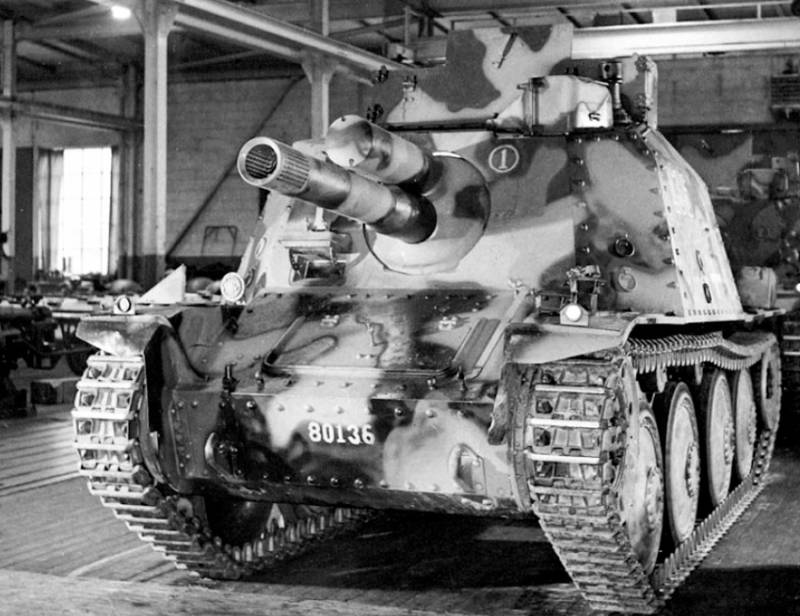 Overview of the armored vehicle of the second version. Photo Ftr.wot-news.com
Overview of the armored vehicle of the second version. Photo Ftr.wot-news.comThe light tank of the basic model had armor up to 25 mm thick. The Pav m / 43 project proposed to increase protection. The forehead of the hull and cabin is now 55 mm thick. On the sides, the crew is covered with 30 mm panels of the hull and cabin. The roof should be made of 10 mm thick panels. Other hull elements are borrowed from the Strv m / 43 and their thickness remains unchanged.
The layout of the hull was redesigned to accommodate the new weapons. The forward section, as before, had to house the transmission equipment. Just behind it was placed a single volume that could accommodate work for all crew members. The power supply was provided under the engine and some related systems.
The promising self-propelled gun was proposed to be equipped with a Scania-Vabis 1664 gasoline engine with a capacity of 142 horsepower. With the help of a cardan shaft running along the body of the vehicle, the engine was connected to a mechanical gearbox mounted at the front. The gearbox was connected to the front drive wheels.
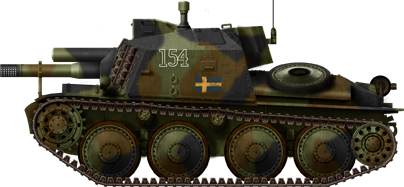 Reconstruction of self-propelled artillery with reinforced weapons. Photo Tanks-encyclopedia.com
Reconstruction of self-propelled artillery with reinforced weapons. Photo Tanks-encyclopedia.comLike the tank of the basic models, the new Swedish self-propelled gun was supposed to have a chassis built on the basis of four road wheels on each side. Large diameter rollers were blocked in pairs and mounted on spring suspensions. Large steering wheels were placed at the front of the hull. At the stern, it was planned to install guide wheels of smaller diameter. Above the gap between the front wheels were placed two pairs of support rollers. The design of the caterpillar in the new project remained unchanged.
According to the original plan, the new self-propelled gun was to receive advanced guns with a caliber of 105 mm. However, the Bofors company was not able to complete the development of such weapons in time, which is why the first Pav m / 43 prototype and some production vehicles received weapons of lower power. However, the gun mount was created taking into account the installation of the system that was originally required. As a result, two variants of self-propelled guns, different in armament, had some external similarities.
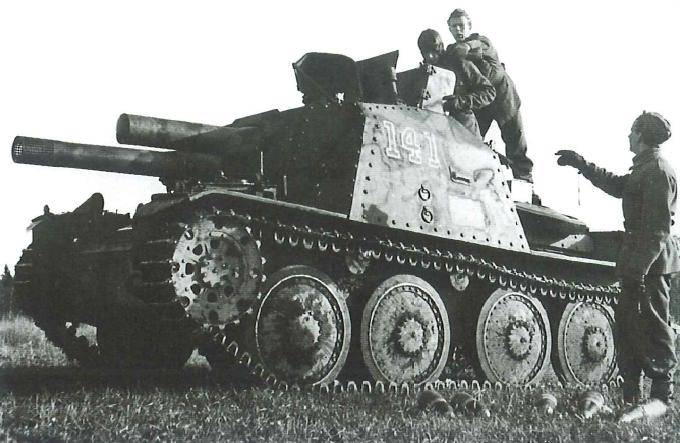 Sav m/43 series in the military. Photo by Wikimedia Commons
Sav m/43 series in the military. Photo by Wikimedia CommonsThe first version of the combat vehicle received a Bofors m / 02 rifle with a caliber of 75 mm and a barrel length of 50 calibers. The gun was mounted on a universal mount and moved out of the cabin with the help of a large circular embrasure covered with a hemispherical mask. Together with the barrel, a guide beam protruded outside the fighting compartment, holding the barrel in the desired position. Later, the mask was redesigned, taking into account other dimensions and the design of a larger weapon. The design of the gun mount made it possible to aim the gun vertically and horizontally in confined areas.
The 75 mm gun is supposed to use single shots with different types of ammunition and for different purposes. The ammunition consists of several dozen shells placed on racks in the fighting compartment. Reloading is done manually. For guidance, the crew can use telescopic and panoramic sights.
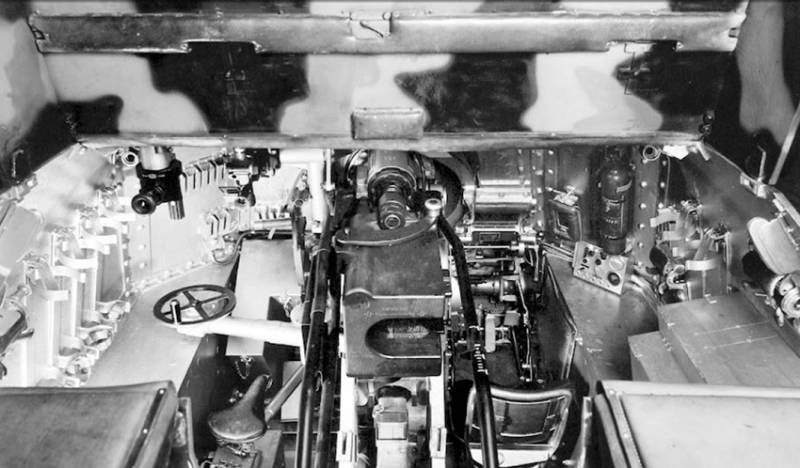 The interior of the habitable compartment. Photo by Ointres.se
The interior of the habitable compartment. Photo by Ointres.seThe Pansarartillerivagn m/43 / Stormartillerivagn m/43 project did not provide for the use of standard auxiliary weapons. In an emergency, the crew could have a personal weapon, from which it could fire through the hatch of the fighting compartment. The gun mount was lost.
The crew of the self-propelled gun consisted of four people, housed in a single fighting compartment. To the right of the gun mount at the front of the hull was the driver. He could follow the path with the help of a rectangular hatch in the front panel, covered by a slotted flap. To the left of the gun was the gunner, who had an aiming system and a guidance system at his disposal. The commander and the loader had to work in the rear of the cabin. Inspection hatches were cut on the sides next to them. Access to the habitable compartment was provided by a large hatch in the rear of the roof. The cover of this hatch, which had a complex polygonal shape, was actually part of the cabin roof.
The total length of the new self-propelled gun is 5.05 m, width – 2.14 m, height – 2.3 m, combat weight is determined to be 12 tons, it is noteworthy that despite the short barrel length, its muzzle protrudes beyond the hull projection. However, this design feature is not considered a disadvantage. The specific power at the level of 11.8 hp. per ton allowed to obtain acceptable indicators of mobility. The maximum speed on the highway is 45 km / h. Power reserve – 180 km. In terms of durability and ability to overcome obstacles, the self-propelled gun Pav m/43 does not differ from the base tank Strv m/41.
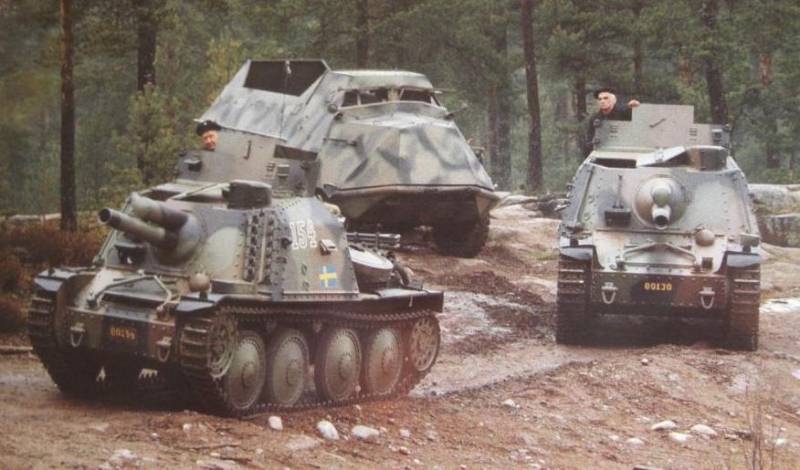 Self-propelled artillery in training. Photo Namu.wiki
Self-propelled artillery in training. Photo Namu.wikiThe first prototype of a promising self-propelled gun, designated Pansarartillerivagn m/43, was built in mid-1943 and put through trials, in which representatives of the Swedish military department took part. Despite the use of a reduced-caliber gun, the experimental armored vehicle performed well and proved its ability to solve all assigned combat tasks. Depending on the situation on the battlefield, the self-propelled gun could fire directly or fire at targets from a closed position, raising the barrel at a high angle.
In March 1944, after successfully completing all the tests, the new self-propelled gun was put into service under the designation Stormartillerivagn m/43 or Sav m/43. In addition, Scania-Vabis received an order for mass production of 18 armored vehicles. It was assumed that the necessary equipment would be produced within a few months and that the parts would soon arrive. However, the assembly of the armored vehicles was slightly delayed. As a result, the first batch of self-propelled guns was adopted into service only in April 1945. Over the next few weeks, the army received the remaining self-propelled guns.
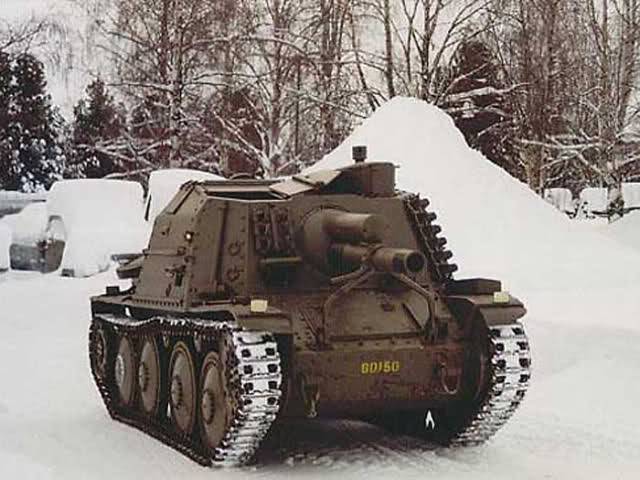 Stormartillerivagn m/43 in series at the training ground. Photo Namu.wiki
Stormartillerivagn m/43 in series at the training ground. Photo Namu.wiki18 Sav m / 43 vehicles were transferred to two assault artillery battalions, each battalion formed three batteries. The corresponding batteries consisted of three self-propelled guns. Already in January 1945, two new divisions took part in the maneuvers. During the exercises, the crews of the equipment coped with the assigned tasks. The self-propelled guns received the highest assessment. Soon after, in order to avoid possible unpleasant incidents, six batteries of the two divisions were transferred to one of the sectors of the Swedish-Norwegian border. These formations remained there until the end of the war in Europe.
Only in mid-1945 was the Bofors company able to start producing the new 105 mm caliber m / 44 howitzer, which made it possible to meet the initial requirements of the Pav m / 43 / Sav m / 43 project. Such guns were equipped with a barrel 27 calibers long and had a developed muzzle brake. A larger caliber significantly increased the main combat characteristics, and at the same time made it possible to deal with various targets with greater efficiency. The appearance of a ready-to-production tool, distinguished by greater power, had a positive effect on the existing fleet of equipment.
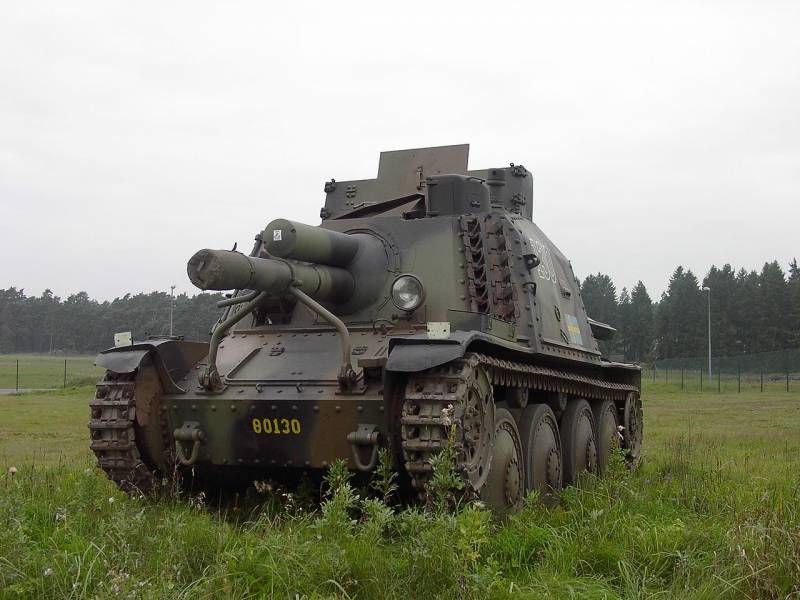 One of the surviving museum self-propelled guns. Photo by Wikimedia Commons
One of the surviving museum self-propelled guns. Photo by Wikimedia CommonsAlready in 1945, Scania-Vabis and Bofors began to modernize the Sav m / 43 self-propelled guns with cash. All 18 armored vehicles lost their existing 75-mm guns and received more powerful weapons. Together with the new howitzer, they received a larger gun. In addition, based on the experience of operating existing machines, the existing cutting was improved. The introduced changes affected the complex of observation equipment, as well as improved the ergonomics of the fighting compartment.
A large-caliber pistol with a developed recoil device received a new mask. A hemispherical part with a protruding housing of the recoil brake cylinder was placed in the embrasure. Under it there was a hole for the barrel outlet. Despite the use of a new mask, the capabilities of the gun mount in terms of aiming angles did not change.
The crews of self-propelled guns were hardly satisfied with the need to land through a single hatch in the roof. To solve this problem, a separate hatch appeared above the driver’s seat. A new sight, designed for use with a more powerful gun, had to be placed on the roof of the cabin; the head of the sight protruding above it received a molded box-shaped housing with a hinged front cover. On the front and zygomatic panels of the cabin, it was proposed to carry spare grooves for the rails, which to a certain extent increased the level of protection.
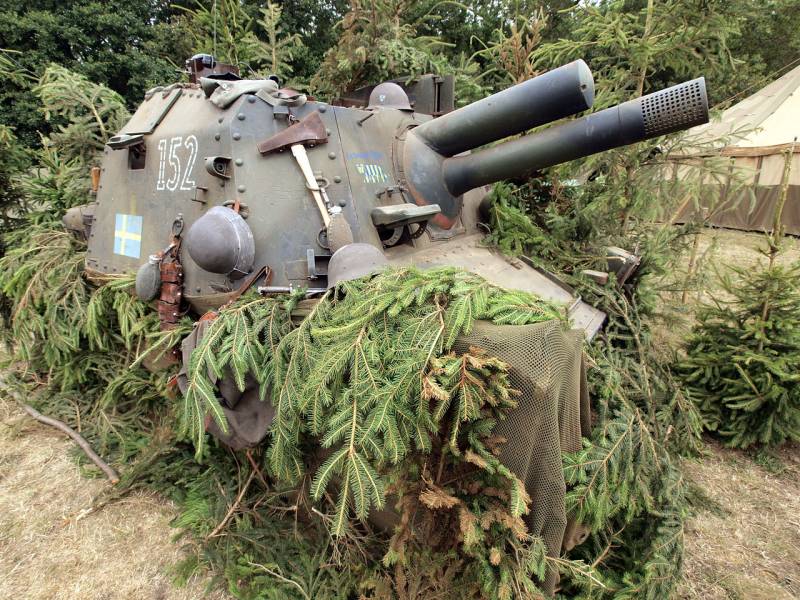 Museum exhibit with camouflage. Photo by Wikimedia Commons
Museum exhibit with camouflage. Photo by Wikimedia CommonsAfter the modernization of the already built self-propelled guns was completed, an order was placed for the construction of 18 more Stormartillerivagn m/43 armored vehicles armed with powerful 105 mm howitzers. The assembly of this technology continued until the end of 1947. As a result of two orders, the Swedish army had 36 self-propelled guns with relatively powerful weapons. This technology was distributed to four divisions, each with 9 vehicles.
Until the early 1951s, self-propelled guns served as part of the artillery. In 1951, units equipped with such equipment were transferred to the armored forces. After that, their affiliation did not change. In its original form, the Sav m / 43 self-propelled guns were operated until the late 41s. Then it was decided to upgrade them, taking into account the experience of updating other armored vehicles. At this time, a certain number of Strv m / 160 tanks with an updated power plant were produced. By the early sixties, the same XNUMX-horsepower engines were also installed on the Stormartillerivagn m / XNUMX. The means of communication were also upgraded.
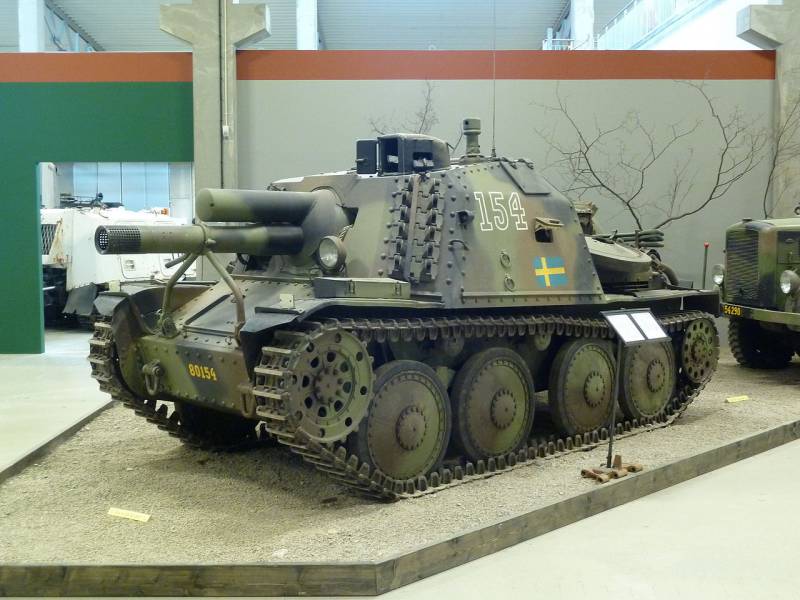 Self-propelled gun in the Swedish Arsenalen museum. Photo by Wikimedia Commons
Self-propelled gun in the Swedish Arsenalen museum. Photo by Wikimedia CommonsFor a long time, Sweden maintained a neutral stance and did not participate in armed conflicts. In this regard, its army had the opportunity to use its equipment only in various combat training operations. As a result, all serial Sav m/43s fired only on training grounds and only at training targets. They, like many other models of armored vehicles produced by Sweden, were never able to participate in a real war.
For obvious reasons, Swedish self-propelled guns quickly lost their potential in the context of combating enemy armored vehicles. However, they could still be used as a means of fire support for the army. Sufficiently powerful weapons and updated power plants allowed the Sav m / 43 self-propelled guns to serve for a long time. The issue of scrapping such machines was solved only in the early seventies. The last self-propelled guns were withdrawn from service and were decommissioned only in 1973, when newer vehicles with similar purposes were adopted by the army.
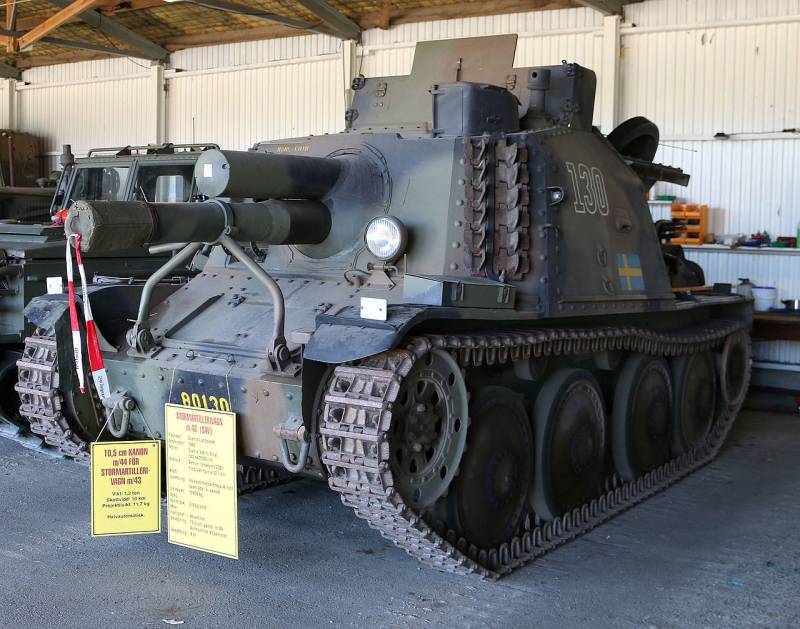 Sav m/43 from the collection of the Artillery Museum in Kristianstad. Photo by Wikimedia Commons
Sav m/43 from the collection of the Artillery Museum in Kristianstad. Photo by Wikimedia CommonsAll serially produced Stormartillerivagn m/43s were sent to storage. Most of the machines were subsequently recycled, although a significant number of such devices have survived. Seven self-propelled guns are currently in museums and private collections in Sweden. Two more examples have somehow ended up in museums in the United Kingdom. Similar exhibits are stored in Germany, France and the Czech Republic. The surviving self-propelled guns are in a different state, some still in motion.
The goal of the Pansarartillerivagn m/43 or Stormartillerivagn m/43 project was to create a promising self-propelled gun capable of hitting targets on the battlefield or in tactical depth. At the same time, it was planned to adapt the vehicle to the difficult conditions of Sweden, as well as to make it as cheap as possible. All these tasks, in general, were successfully solved. The army received a significant number of new armored vehicles, which were distinguished by quite high firepower. The specific terrain conditions, the military-political situation in the region, technical characteristics and other factors allowed the self-propelled gun, created according to the concepts of the Second World War, to remain in service for almost three decades.
According to the website: http://ointres.se/http://tanks-encyclopedia.com/http://the.shadock.free.fr/http://wwiivehicles.com/http://shushpanzer-ru.livejournal.com/http://alex-mistch.livejournal.com/